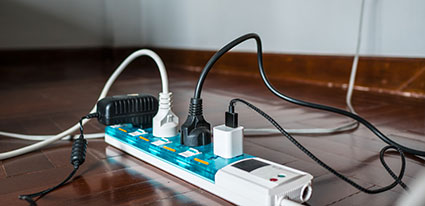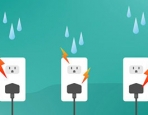Have you ever had multiple electrical appliances in your home act up at the same time? This could be flickering lights, turning off and on, or even having devices die on you completely.
If you haven’t experienced this, luckily you’ve never had to deal with the results of a power surge. However, not every electrical surge is the same and you may have experienced a minor one without even realising.
The Science Behind Power Surges
A power surge occurs whenever there is a sudden increase in the voltage entering your premise. The mains voltage used in Australia is 230V and 50Hz. Meaning that every standard electrical socket can supply 220-240V of electricity to whatever device is connected. However, when there is a sudden increase in the voltage provided (called a power surge), the connected devices are put at risk of damage due to the higher than usual voltage.
Common Causes of Power Surges
But what causes this sudden increase in voltage?
One of the major causes of power surges is faulty wiring. Luckily, unlike other potential causes, is something that we have complete control over. When the electrical wiring of a premise is not properly installed, electricity is not properly distributed and may cause sudden spikes of electricity to potentially dangerous levels. However, professional electricians offer fault finding services to detect these problems before they can damage your expensive appliaces.
Another common cause of electrical surges is the usage of high powered appliances that demand a lot of electricity, such as air conditioners and refrigerators. However, even with devices that don’t demand large amounts of electricity, an electrical overload can occur when a single electrical socket is overloaded. This could mean plugging too many devices or using multiple power extensions.
Unfortunately, there are some factors that may cause a power surge that is completely out of our control. For example, storms and lightning strikes can cause electrical output to suddenly spike up.
Although we can’t control every possible factor that can cause a power surge, we can greatly minimise it through the proper usage of electricity and with the aid of an electrician. Additionally, there are products that can help prevent a power surge from damaging your appliances.
Products To Prevent Power Surge Damage
Surge Protectors
Similar to a standard power strip, a surge protector allows you to plug in your appliances, but with the added benefit of including built-in safety mechanisms to absorb excess electricity that may occur with a power surge. As an added safety precaution, they have mechanical features to reliably cut off the flow of electricity to your devices using physical means. This means that you don’t have to worry about technological faults preventing your surge protector from doing its job.
Surge Diverter
Unlike a surge protector, a surge diverter redirects excess voltage to the ground. This is connected directly to your main power board, rather than to your electrical outlets. When voltages exceed 260V, the electrical power will be grounded rather than be sent to your devices. This is extremely beneficial as it means your entire premise is better protected from a power surge. However, this is an installation that must be made from a professional electrician and isn’t a DIY solution like purchasing a new powerboard.
Which power surge solution is right for me?
It is highly recommended that you invest in both surge protectors and a diverter. The reason for this is because with the slim chance that one of these devices may fail, the other is very likely to prevent any damage from occurring.
One power surge without a preventative device in place could lead to a broken toaster, computer, or piece of expensive machinery. To make matters worse, the chances of multiple appliances being connected to a single electrical outlet are high. This could lead to the destruction of multiple appliances at once.
But by investing in both of these devices, you’re protecting all your appliances from damage at a fraction of what it would cost ot have them replaced.
Power Surges & Destroyed Appliances
Have you experienced a power surge recently and found yourself with damaged devices?
In some cases, this could be claimed as a loss through your home and content insurer. However, this will depend greatly on the individual circumstances that caused the electrical surge and the policies of your insurer.
For example, some insurers cover damaged appliances and other losses caused by lightning strikes but not if it’s caused by failure from your energy provider.
If you’re not sure whether or not your insurer covers these damages, just reach out to them and give it a try. Damages can be extremely expensive and trying to claim through your insurance provider is definitely worth the time.



